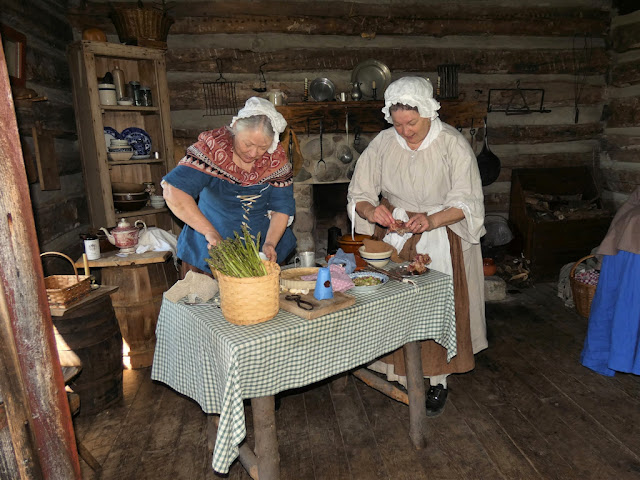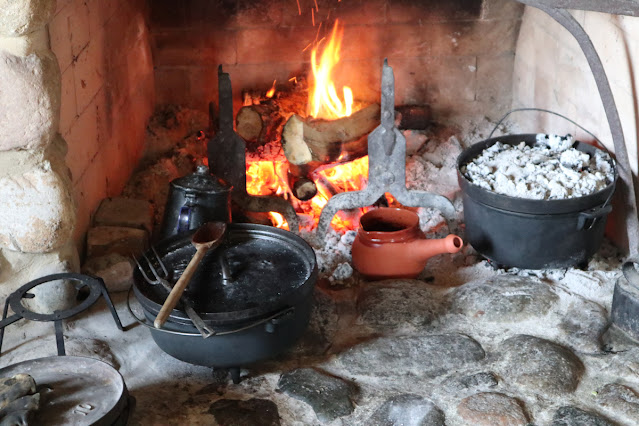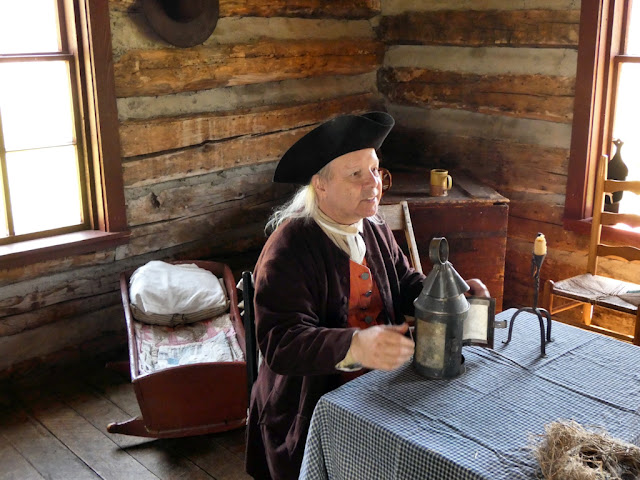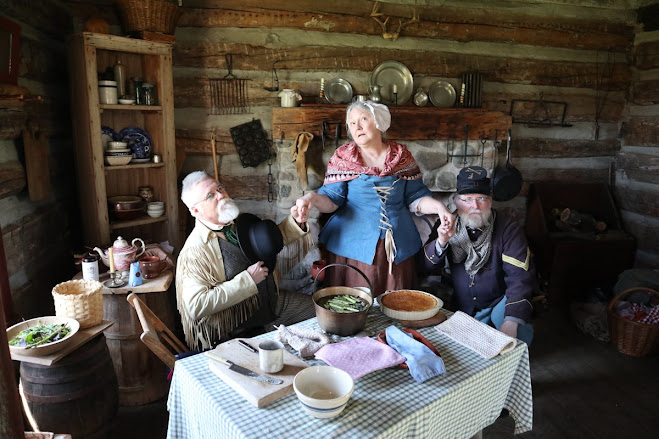A glowing bed of red-hot coals burned on the hearth, strokes of morning sunlight glanced through the eastern windows and touched the checkered cloth on the dinner table. In the south window we see the patch of plowed and harrowed dirt a-waiting the flax seeds. There was an atmosphere of homely cheer and comfort in the room.
Yeah...that's where I'm at...
..................................................
For most of the week previous, the National Weather Service continued to tell us to expect cooler temperatures, mostly cloudy with spots of sun, and off & on rain showers throughout event day. Even on the evening before they said to watch for off & on rain showers, mostly cloudy skies, and cooler temps.
"Oh well," I thought to myself, "It rained in the 1770s, too, so we'll just make the best of it. We'll chalk it up to another way of experiencing the past."
 |
| Lovely ladies of the 18th century. |
Not that complaints could change the weather, but this living history excursion was more than just our usual time-traveling gang of living historians - me, Larissa, Jackie, and Charlotte - at the cabin; for this event, my wife Patty was going to join up with us, which she hadn't done before (though she did come and help me to pull flax last summer). plus it was Free Museum Day in Jackson County:
Visit your favorite Jackson museums on Museum Day for FREE on Saturday, May 7, 2022 (between 10 AM and 4 PM). Eleven Jackson County museum locations will host an “open-house style” reception and self-guided tours alongside child-friendly activities, historical demonstrations, and providing guided tours during the event.
*sigh*
Perfect weather would have made for a perfect day.
So I was more than a little surprised upon waking very early on Saturday morning to find a bright sunrise amidst a clear sky.
Where're the clouds and spotty rain?
It continued to stay clear as I loaded up the van.
It was clear the entire 90 mile journey to the cabin location. In fact, it remained clear the entire live-long day! Not a cloud in the sky with temperatures reaching the mid-60s!!
God's blessings reigned upon us instead of rained upon us!
 |
| Ken planting flax seeds in rows... |
Yes, it's springtime here in 2022, and people are out preparing and planting gardens and enjoying the sunshine.
And so were we.
Mankind has always lived by the seasons of the year. Oh, I know that there are areas on this planet where seasons differ, but my postings mostly concentrate above the Mason-Dixon Line here in the United States, where winter, spring, summer, and fall each make their annual visits.
So there we were on May 7th, celebrating a colonial spring during Free Museum Day, sunshine-blue skies...and 60+ degrees. I had my sack of flax seeds in hand, on my knees, sowing the plant that will be harvested in three months.
 |
| Charlotte scattering flax seeds... |
Prior to the invention of the seed drill by Jethro Tull (in 1701), sowing seeds was done by hand, by scattering them on the ground or placing them in the ground individually. Tull's drill was a mechanical seeder that sowed efficiently at the correct depth and spacing and then covered the seed so that it could grow. Now, that's not to say that immediately following its invention that everyone had such a contraption and began planting in this manner. Like nearly anything else, tradition dies hard and news traveled much slower in the 18th century, so, though planting in rows occurred before and after the seed drill, not everyone followed suit. So we here at the cabin tried both ways: I went with planting in rows while on my hands and knees, since there was no seed drill for us to use, and Charlotte tried by scattering the seeds in the more traditional manner.
 |
| And my wife did her part by raking out the dirt. |
According to a gardening historian from Colonial Williamsburg: "I don't think the basics of gardening in the 18th century is all that different than in the 21st century. Gardening has evolved but the basics of preparing the seedbed; germinating seeds and caring for a plant remain similar. It’s the same environment and soil that John Randolph wrote about in 1793. For example, materials like dung that Mr. Randolph mentioned, animal remains, and potash salts made from wood ashes were the primary ingredients used to replace nutrients in the soil. Farmers relied on whatever was available locally. The soil continues to be the main ingredient to a garden’s success."
 |
| Patty was tying the water bucket ropes to the yoke. |
 |
| With buckets filled with water, we had the kids see what it was like to carry liquid, whether water or milk from the cow, in this manner. |
Of course they would---they did not grow up with this chore, so naturally for them it would be a very tough task. But as there were no hoses for watering in the 18th century, the only way to get the water
to the seeds was by way of water buckets and the yoke.
Now, as for my watering jug...
Although the basics of gardening remains the same, the way we eat is radically different than in the 18th century. As 21st century members of society, we don’t have to grow and preserve enough food to last our family the entire year. Stepping out to the store to purchase fresh meats, vegetables, fruits, and other produce isn't given much thought here in 2022.
 |
| But, in 1772 - - - - we have fresh asparagus!! This is why we love May so much - the greens are popping up! |
In the 18th century, after spending months eating dried vegetables, there could be no bigger treat than something like asparagus in May!
And were they delicious!
As members of the living history group Citizens of the American Colonies, what makes us a bit different - not better or worse - from the typical reenactor or museum interpreter is, though we make sure we acknowledge and present to any visiting public that may come our way, we still go throughout the day as if we were actually living there in that cabin in 1772. We don't speak necessarily in a 1st person manner; however we do our best to stray away from modern talk. And the spectators may find us in a situation or in historical conversations depicting mannerisms of the time we are representing.
The ladies of the frontier cabin:
 |
| Patty & Larissa were helping to prepare our dinner meal. |
 |
| Jackie and Charlotte did the same. |
 |
| Look who made a whisk! |
 |
| Cooking on the hearth~ To be able to eat a traditional meal cooked on the hearth is another dream of mine I've had since childhood, ever since reading "The Cabin Faced West." I remember asking my dad & mom if we could have a meal cooked on our hearth, for our home had two fireplaces. Of course, the answer was a resounding "no" - - - this sort of thing was just not done in the late 1960s and 1970s, and living history was pretty much an unknown rarity at the time to most people, especially outside of a historic home. |
 |
| I am always impressed with the food the ladies come up with. It is always period-correct - I've not been disappointed yet. |
 |
| Yep---we brought the pipkin back again to warm our cider. The pipkin is that odd-looking redware cooking apparatus you see toward the center of the picture. |
 |
| Jackie not only made bread, but a pie as well. |
And there was time for crafts as well:
 |
My wife can knit while standing, walking, talking...most anywhere! |
 |
| Charlotte...taking a bit of a breather. |
 |
| Not too lonely on this day, though, for we had plenty of spectators to speak to. In this shot I was explaining about the lanthorn and the rush light. |
 |
| Being that this was Free Museum Day in Jackson County here in Michigan, well over 500 visitors came through to learn about America's history. |
As I delve deeper into the world of living history I find myself wanting to experience a state of immersion into the 18th century. We, as living historians, will hone our historical skills. For instance, we find ourselves learning trades and crafts of earlier eras not very often practiced in modern society, whether it is candlemaking, flax preparation, spinning, knitting, leather and tin work, or even cooking on the hearth.
And taking every step to make sure that when I transport myself into the past that there is no 1979 penny to unwittingly bring me back to the future ~(remember that scene from the movie "Somewhere in Time" when Richard Collier, after traveling through time to 1912, discovers a penny from 1979 that immediately brings him back to his original time in the future?
Yeah...I try to keep the modernisms at bay as best as can be done.
And for a little bit of fun:
 |
| Two men from 90 years into the future - the 1860s - somehow found their way back in time to locate their beloved Jacqueline! |
To learn more of this...um...love conundrum - a "future" back story, click HERE (I think you will find it entertaining).
And there you have it - our second spring in the 1770s.
These special days at the cabin are, perhaps, the highlight of my reenacting year. The physical and mental experience we each receive at each of these is beyond anything any of us could have imagined or wished for. And when you can wear historic clothing and it doesn't feel odd, uncomfortable, or like a costume, that's when you can almost be certain you are doing it right (remember: I did say "almost").
It has been a want for me personally to work at historic Greenfield Village since I was a young adult, but I just could not afford to quit my higher-paying job to do so.
 |
| Oh my aching sciatic nerve! But I did it - spring has sprung, and planting season has begun! |
However, I believe what we as a group (and me personally) have been doing at the cabin may even be better for me than working at the Village! We've all been getting true experience gained from the shared knowledge of the four of us and applying it.
Living the research.
In doing so we can pass these experiences on as teaching moments. It also satisfies the hunger and thirst we have - this passion we have for the past. It may be sorely overlooked in history books at schools and colleges, but history is made from regular everyday people - the citizens - who survived under what we would consider harsh conditions. We need to learn of those who are not unlike you and I - the majority...both men and women - who may not have gotten their names in the history books, but were, nonetheless, every bit as great and important as anyone else - (like you and I are in our modern day). Unfortunately, many folks have a tendency in our day and age to over-simplify the roles of a colonial family with the insinuation that those who lived before our own "enlightened" time were backwoods, backwards, and just not as intelligent as we are. But I heard such a great line from someone on C-Span a few years back that explains it all perfectly: "People in the past were every bit as smart as people are today. They just lived in a different time."
That's how we, as historians, can fully understand the times in which they lived.
And perhaps not be so judgmental in looking back at them from the 21st century. They do not deserve such harsh judgment.
Until next time, see you in time.
<>
I cannot thank the good folks at the Waterloo Farm Museum enough for allowing us to live out long-time historical dreams. I appreciate the trust you have given us.
See you in the spring!
Also, so many thanks to the wonderful living historians who joined me - Larissa, Charlotte, and Rebecca - for it was because of their want of these time-travel experiences that we could, together, make it happen.
I am proud to call you my friends.
And to Bob Jacobs for taking so many of the photos you see here - thank you sir! There's a meal coming your way!
To read about our 2020 autumn excursion at the cabin, click HERE
To read about our 2021 wintertime excursion at the cabin, click HERE
To read about our 2021 springtime excursion at the cabin, click HERETo read about our 2021 summertime excursion at the cabin, click HERE
To read about our 2021 harvesting of the flax at the cabin, please click HERE
To read about our 2021 autumn excursion making candles at the cabin, click HERE
To read about our 2022 winter excursion at the cabin, please click HERE
To learn about historic farm tools, please click HERE
To learn about a year on a colonial farm - living by the seasons - click HERE
To learn about colonial textiles, click HERE
To learn about a colonial spring, please click HERE
To learn how colonials lived with candle light, click HERE
Adding everyday life to colonial living, click HERE
To purchase a wonderful DVD about colonial daily life, including farming, click HERE
~ ~ ~








Lovely spring post! I always enjoy your blog's content.
ReplyDelete